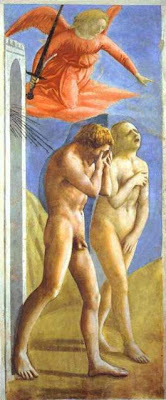I painted, and my picture was like life;
I gave my figures movement, passion, soul:
They breathed. Thus, all others
Buonarroti taught; he learnt from me.
By Annibal Caro, Italian Poet
and
O jealous Fate, why doth thy finger fell
Asunder pluck the threads of youth's first bloom?
Countless Apelles this one slaying slays;
In this one death there dies all painting's charm.
With this sun's quenching, all the stars are quench'd;
Beside this fall, alas! all beauty falls.
By Fabio Segni (Translated from Italian)
Source for the poetry: Vasari, Giorgio. Lives of the Artists. Translated by Bull, George. Penguin Books.
Masaccio, one of the predecessors to the Great Masters of the Renaissance was studied closely by many of the Great Masters and it is speculated that Michelangelo studied Masaccio by making sketches and drawings which surpassed the works of Masaccio. The amount of drawings is information which is debated by art historians including Vasari.
 |
| Expulsion from Eden, Masaccio, fresco from Brancacci Chapel, Florence. Image from http://archives.evergreen.edu/webpages/curricular/2006-2007/greeceanditaly/massacio-expulsion-from-eden-1427-fresco-from-brancacci-chapel-florence/index.html |
Masaccio's Expulsion from Eden, 1427, fresco from Brancacci Chapel, Florence was drawn by Michelangelo (Copy of Masaccio, Expulsion c.1490).
 |
| Copy of Masaccio, Expulsion. Michelangelo, Drawing, c. 1490 |
Tribute Money, located in the Chapel of Santa Maria della Carmine, Florence, Italy is perhaps one of the most recognized works of Masaccio. Masaccio based the heads of the figures on classical heads yet his figures were akin to Donatello's.
 |
| Tribute Money, Fresco, 1426-28, 255 x 598 cm, Masaccio, Chapel of Santa Maria della Carmine in Florence, Italy. Image from Hanover College |
Masaccio was not the inventor of linear perspective but perhaps completed one of the early Renaissance's most effective use of perspective in The Holy Trinity. Unknowingly, Masaccio would further the argument of mathematics as a true science. Masaccio constructed the fresco carefully according to the lines of linear perspective which Brunelleschi had perfected and painted the work to be seen from eye-level.
 |
| The Holy Trinity, 1425, Masaccio. Santa Maria Novella, Florence, Italy. Here the lines following Masaccio's actual geometric framework are overlaid to make clear the structure of the perspective itself. Image obtained from McMurry University |
The viewer first encounters the skeleton and inscription "I was once that which you are; and that which I am you will become." The viewer is meant by the gaze of only one individual in the fresco, the Virgin who invites the viewer into this constructed illusion and hence into contemplation of their humanity and meditation on her son.
 |
| The Holy Trinity, 1425, Masaccio. Santa Maria Novella, Florence, Italy Image obtained from http://legacy.earlham.edu/~vanbma/20th%20century/images/surveydaytwentynine.htm |

No comments:
Post a Comment